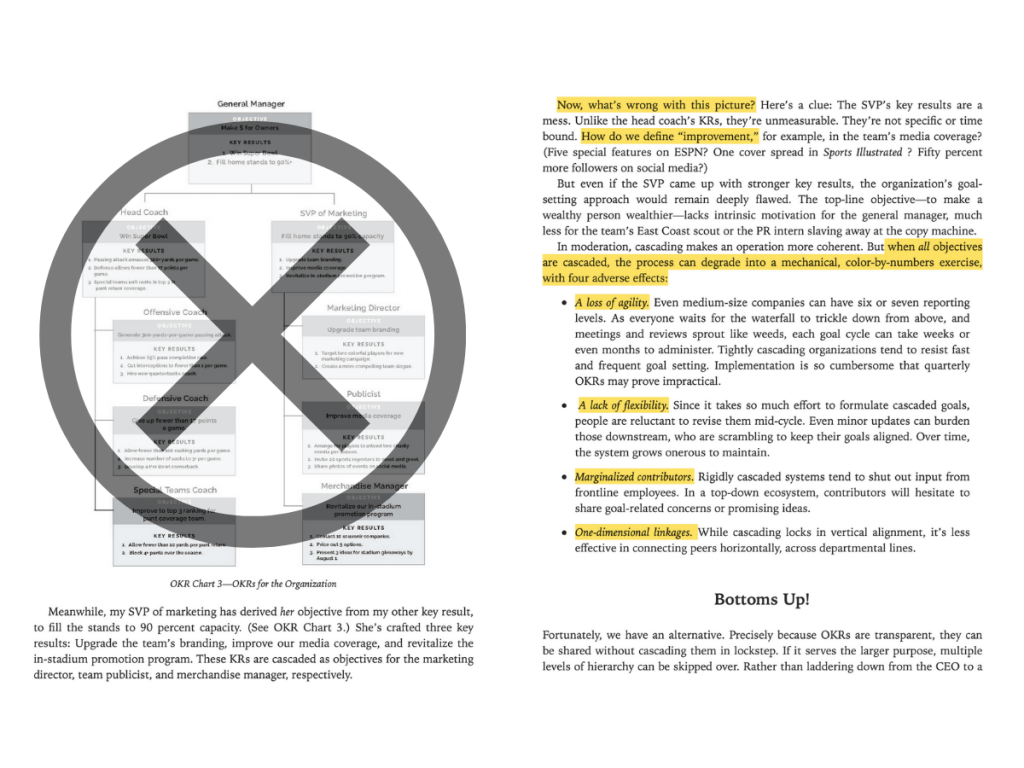
There is a famous quote by Leo Tolstoy: “Happy families are all alike; every unhappy family is unhappy in its own way.”
As wise as the saying is, it does not apply to businesses.
It’s quite the opposite: successful organizations are successful in their own way (think Apple versus Google); and every failed company has made all of the same mistakes that others made long before them.
This rule holds true for the company-wide rollout of OKRs. Objectives and Key Results is a goal-setting method that helps to accelerate growth, and if you are doing it right, it will help you fulfill your vision and build a successful company.
But it seems like 7 out of 10 companies lose patience and fail to see any real improvement in their business.
What’s the catch?
In this article, we collected the top 10 reasons why you are not seeing the benefits of the OKR methodology just yet and what to do about it.
Before we go into details, take a look at the list to see if anything looks familiar.
- Why OKRs aren’t working?
- Reason # 1: You copied examples from “Measure What Matters”
- Reason #2: You gave up on writing measurable KRs
- Reason #3: Your KRs are performance targets (KPIs)
- Reason #4: You turned measurable KRs into lower level Objectives
- Reason #5: Your Objectives are actually projects
- Reason #6: Everything you do is an OKR
- Reason #7: You demand personal OKRs from all team members
- Reason #8: You are not following a quarterly cycle
- Reason #9: You are not doing weekly check-ins and retrospective reviews
- Reason #10: You went head-first into OKRs without training and preparation
- So what makes OKRs work?
Why OKRs aren’t working?
It’s fairly simple. OKR is a method and if you don’t apply it correctly, it’s not going to work. You need to follow the best practices.
Here is what one of our customers said on this topic:
“OKR is not a no-brainer. It takes practice and patience to find the right path for you. This can be very demotivating, especially in small, growing companies where many foundations still need to be laid and data is sometimes lacking as a basis for measuring progress.”
Kim Strehl, HR Manager, Wawibox
So that’s it then? Just google the best practice advice and be happy?
The problem is that many people who are giving out free advice on the internet have never tried implementing OKRs for real, and, more importantly, never tried introducing the methodology to the entire organization with more than 10 people.
These are just a few symptoms you might be noticing if you followed poorly worded advice:
- OKRs are not engaging and people forget about them;
- Some teams insist that they have no way of writing measurable Key Results;
- It takes ages for some teams to get started on their OKRs;
- Team managers push back and insist that OKRs are a waste of time and extra work with no value.
Does any of this ring a bell? It’s not your fault, and we will help you fix it.
Your OKR journey will be unique but we want you to be aware of dos and don’ts – the best practice advice curated by Weekdone experts and based on their experience in the field.
Let’s run through some reasons why your OKR process might not be working and discuss solutions for these issues.
Reason # 1: You copied examples from “Measure What Matters”
“Measure What Matters” by John Doerr is an OKR Bible. The book does a wonderful job of motivating CEOs into considering this tremendous change in management approach.
But that’s exactly the point: OKRs are a change in management style, and this process requires significant workflow adjustments.
One of the most famous examples from “Measure What Matters” is the sports analogy that John Doerr presented to Google founders in the early 2000s to explain how the OKRs worked in Intel in 1976.
There is a chart in the book that illustrates this example and a top-down approach to structuring OKRs. But then right after this chart, the author explains what is wrong with this example.

Namely, when a higher level measurable KR becomes an Objective for a lower level, it leads to a loss of agility.
We might add that it also leads to initiatives overload, confusion, a lack of focus, misalignment, and defeats the whole purpose of the OKR methodology.
Most people are visual learners, and when we see a chart, we look no further. So no wonder that this example is taken as a word of advice.
Here are some more tips on how to avoid OKR fake news from Felipe Castro (OKR expert).
So, if this is wrong, how should you actually structure the OKR tree?
That’s the change in management style we were referring to: every lower level OKR should link up to a higher level Objective, not the other way around.
This way you can ensure that different functional teams are moving in the same direction, and avoid the situation in the picture below.

Your goal-setting flow should go like this:
- Leaders present Company level Objectives with necessary context and explanations.
- Teams develop their team-specific qualitative Objectives and measurable Key Results that would drive the Company Objective forward.
- Team members prioritize plans and initiatives to achieve the outcomes defined in their Team OKRs.
Apart from the football analogy, there are many other examples in the book that are widely misunderstood or misinterpreted. But there is no need to go into detail or start an academic debate because you can save some time by checking out this database of good OKR examples for different teams.
Reason #2: You gave up on writing measurable KRs
“The most difficult part [while implementing OKRs] was to educate the team on proper OKR structure. To make sure that the team is not using Objectives as Epics and KRs as subtasks.”
Alexey Dubov, COO and Co-founder, Mighty Buildings
👉 Sign up to Weekdone and access internal Learning Center with step-by-step OKR examples for different teams
There are teams in any company that are used to tracking various metrics. And then, there are teams that are more used to “getting things done” and expecting everyone else to think about the impact of these deliverables. Implementing OKRs is a change to outcome-driven management, and this means involving everyone in the “effort versus value” discussion.
The impact should not just be a concern for the leadership team. Every single team has a part to play in improving the business, and every team can produce observable change that can be quantified and measured throughout the quarter.
👉 Learn more about writing measurable Key Results in our comprehensive guide to OKR implementation.
Reason #3: Your KRs are performance targets (KPIs)
Key Performance Indicators (business metrics and performance targets like revenue, deal size, churn rate, etc.) are usually too big to impact within one quarter so they invite a lot of possibilities and ideas on how to influence them.
These possibilities will keep on coming every day which means, if you put these targets into your KRs, you would end up doing a lot of talking, and not enough of doing. KPIs as KRs lead to a lack of focus and misalignment within the team.
To write a good OKR, think about what needs to change and what kind of improvement areas you could focus on. Define the problem that you are going to solve in your Objective, and ask yourself what kind of measurable change can the team drive within the quarter.
This measurable change would be your Key Results. KRs should be measurable outcomes that define the success of a particular Objective.
Also, the team that owns the OKR should be able to discuss progress every week and learn whether their weekly actions had an impact on the KRs.
So Key Results should help you understand if your effort has value.
Reason #4: You turned measurable KRs into lower level Objectives
This goes back to the sports analogy used in “Measure What Matters” (see point number 1).
Many consultants preach this top-down OKR structure as the best practice advice. But if that’s what you’re doing, you will also be noticing that teams don’t engage with OKRs and refuse to understand the value of the methodology.
Our coaches in Weekdone have helped to implement OKRs in thousands of teams over the course of 7 years, and they continuously insist that cascading company-level measurable KRs makes the entire OKR process a complete failure.
So here is a revelation: Team OKRs will be driving the progress of Company level Objectives, serving as Company level KRs.
This means that on the Company level, you do not need to write measurable Key Results. Because if you do, those KRs end up being high-level metrics that no team can directly impact.
High-level metrics are important to have and monitor but you should put them in their rightful place – in the bucket with all of your KPI targets.
KPIs should not mingle with OKRs because numbers are not problems to solve. Numbers are too abstract, they tend to scare good ideas away and block innovative potential from the discussion.
Team OKRs will be driving the progress of a Company Objective and that is why it is so important for every functional team to understand what the high-level Objective is.
Reason #5: Your Objectives are actually projects
An Objective should be a qualitative statement that communicates either a problem that needs to be solved or a new opportunity that a team will go after. The wording of an Objective matters too, and you can try following this formula: We want to (drive this change) to (solve this problem).
Here is an example.
Bad Objective: Launch a new marketing campaign
Why is it bad: it’s a project, a deliverable, and its purpose is not clear
How to improve it: ask “what are we doing this for?”. What are we trying to impact with this campaign? What is the problem we are solving?
Decent Objective: Improve our digital presence to attract younger audiences
Notice how the first part of the Objective (“Improve our digital presence”) suggests a general improvement area (“we want to drive this change”), and the second part of the Objective (“to attract younger audiences”) explains why you are doing it in the first place (“to solve this problem”).
“Digital presence” here is still quite vague so you may want to clarify what that means. Otherwise, it would be extremely hard to come up with measurable outcomes – Key Results.
Good Objective: Improve our content strategy in Discord and TikTok to attract younger audiences
This Objective is clear. It’s also achievable within the quarter. The team can come up with measurable outcomes to define the success of this Objective and take ownership of achieving them.
Ideally, most Team Objectives should be aligned with the overarching company direction but some Team Objectives might be focused on improving internal processes within the team.
Most importantly, an Objective should give the team a problem to solve, a sense of urgency, and a clear understanding of what matters most for these 90 days.
Reason #6: Everything you do is an OKR
Everyone wants to be productive. But many teams are afraid that if they don’t have 100 items on their to-do list, their manager would say that they are not busy enough and put more responsibilities on their plate.
So, by the logic of it, many people think “the more OKRs we have, the busier we appear”. Obviously, the number of projects you are dealing with does not reflect the value that you are providing and the impact you are having on the business.
In the same way, the number of bugs you fix does not indicate the actual improvement of your digital product.

Make sure that your Team Objectives are focused on improvement areas and your KRs are measurable outcomes you want to achieve within 90 days.
Reason #7: You demand personal OKRs from all team members

Personal OKRs do not work well for organizational goal-setting because they divide the team into individual contributors who are preoccupied with completing day-to-day tasks as opposed to driving valuable business outcomes as a team.
Simply put, one person cannot do what a team can do, so personal OKRs are distractions that slow down the team.
However, personal OKRs might be quite useful for writing goals focused on an individual’s professional growth and personal life improvements but that has no immediate or direct impact on the company’s success so it is quite different from organizational OKRs.
Reason #8: You are not following a quarterly cycle
“In our company, we do planning once a year so we want to set OKRs annually”, said at least a thousand leaders who failed to implement OKRs in their team.
There are 3 reasons why OKRs are set and reviewed on a quarterly basis.
- Even to achieve an annual goal, you need smaller quarterly focus areas. You can never go from 0 to having it all without clear actionable quarterly Objectives. Having annual goals is fine but they should be directional statements (“where do we want to go?”), not OKRs per se.
- You need to stay agile and be ready to recognize new opportunities when they appear, and this would never be possible with annual planning.
- Quarterly goal-setting cadence and weekly check-in process allow you to learn better from retrospective reviews. Setting good OKRs takes time, and driving progress on KRs requires substantial effort, so if you write new OKRs every month, it’s going to feel like you are setting goals all the time, never getting around to actually executing on them.
It might not have been obvious but the power of OKRs comes from the frequency of retrospective discussions and learning in the process.
The ability to learn fast and facilitate continuous improvement is the power source for your future revenue. So don’t rob yourself of the benefits that the quarterly goal-setting cycle has to offer.
Reason #9: You are not doing weekly check-ins and retrospective reviews
“Integrate the framework into your daily routine! Talking about OKRs 1 time a week/month/quarter is not enough. Everybody has to be aware of their contribution and it has to be clear what responsibility comes with it.”
Kim Strehl, HR Manager, Wawibox
Weekly Check-ins and retrospective monthly/quarterly reviews are a means of learning and staying focused.
You are missing out on the true potential of the OKR methodology if you are setting your OKRs at the beginning of a quarter (or worse, a year), and then come back to look at them only when the quarter ends.

We’d like to share two major tips for effective team meetings from an OKR champion and our long-term customer – Kim Strehl (HR Manager in Wawibox):
- The purpose and the agenda of the meetings should be defined and communicated in advance. You should talk about these things regularly and out loud in addition to sharing these guidelines in writing.
- There should be a clear time limit for each meeting:
- During the weekly team check-ins, some topics that come up should not be discussed immediately. Instead, set a separate date and time for this discussion.
- For any organization-wide OKR meeting, there are fixed time limits depending on the topic and the number of attendees.
- The time limits should never be exceeded and should be monitored by the OKR champion.
- After the meeting, team members can provide additional information and answer follow-up questions from other participants. These discussions take place in a Slack channel after the meeting.
Over time, you will develop your own best practices for team meetings, and how to make them engaging. But just remember, it really helps to reiterate the importance of frequent feedback loop and effective communication among team memebers.
Reason #10: You went head-first into OKRs without training and preparation

It’s common for leaders to expect their teams to “figure things out”. This leads to everyone doing OKRs as they see fit. Unfortunately, that’s a recipe for disaster: wasted time, demotivated employees, and zero improvements.
“I found OKRs to be a mix of art and science. Although there is a lot of information out there, you end up modifying or tweaking some things for your organization’s needs.
I would say the most valuable aspect of our implementation of OKRs with Weekdone was having access to an OKR coach who was always available to help.
The coach helped train our employees and guided the leadership team through doubts. I believe this was crucial in our ability to move along as quickly as we did.”
Guillermo Muñiz, Chief Operating Officer, OmniAccess
👉 Sign up for Weekdone. Every subscription includes OKR coaching and step-by-step guidance for your team at no extra cost.
So what makes OKRs work?
Yes, failing is a way of learning. Yes, learning from experience is important. But no one goes into implementing OKRs thinking “let’s fail on purpose and learn from our mistakes”. We all want to start good and start fast.
To summarize, we’d like to mention that there are two distinct reasons why and how the OKR method brings benefits to organizations:
1) the process leading up to writing an OKR (structured discussion with clear agenda and particular vocabulary when talking about goals);
2) the continuous weekly check-in process that allows team members to engage with the OKRs and think about better solutions to drive the outcomes they want to achieve.
You need to nail both of these workflows to make sure that you leverage the benefits of the OKR methodology and accelerate the growth of your business.
